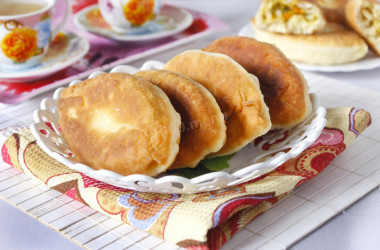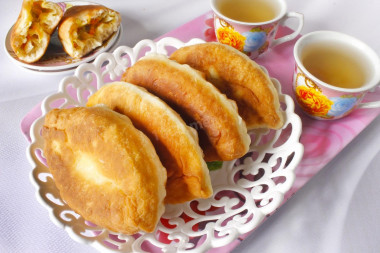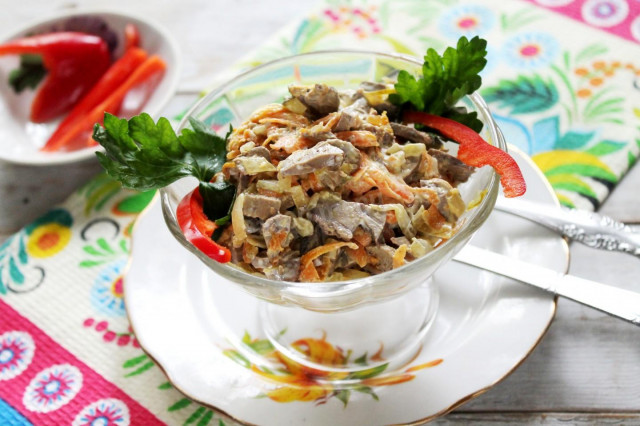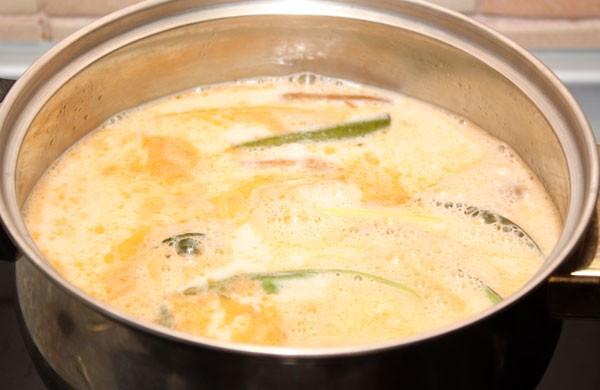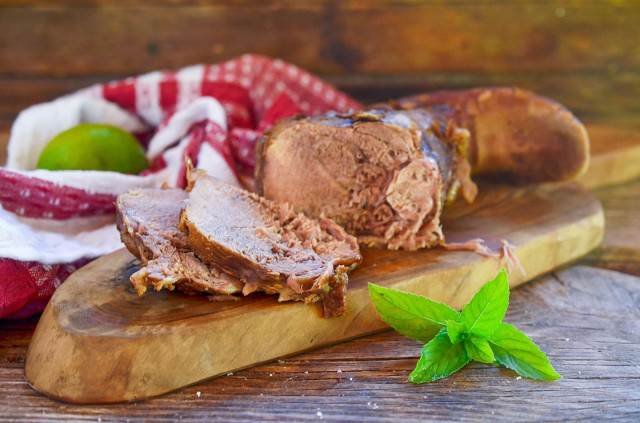Composition / ingredients
Step-by-step cooking
Step 1:
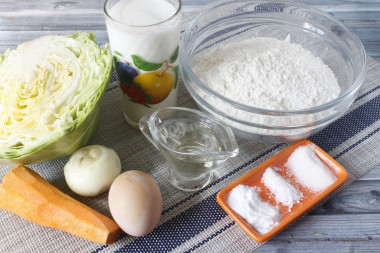
We will need the ingredients listed. Measure out the right amount of them, sift the flour through a small strainer into a dry bowl of a suitable size - sift in order for the dough to come out more airy. Also, for a more successful test, make sure that the kefir and egg are at room temperature, so take them out of the refrigerator in advance. We use refined oil.
Step 2:

Pour kefir into a large wide bowl in which you will knead the dough, beat in the egg, add sugar, salt and soda (can be replaced with baking powder).
Step 3:

Mix everything with a fork or spoon until smooth, let it stand for a couple of minutes so that the soda goes out (the mass foams a little), and pour in vegetable oil. Stir again.
Step 4:
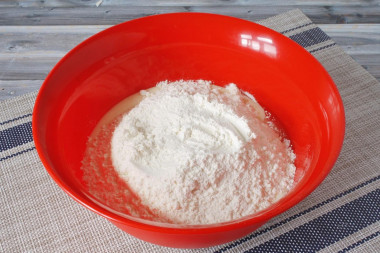
Pour in a large half of the flour.
Step 5:

Mix the mass with a spoon. It will start to thicken.
Step 6:
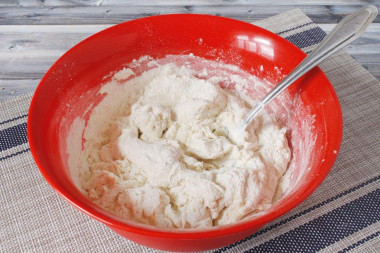
Pour the rest of the flour in two or three batches and mix thoroughly each time. When the dough becomes difficult to knead with a spoon, knead it with your hands.
Step 7:

What consistency should the dough be? The dough should be slightly sticky, it should not be scored with flour. It took me exactly as much flour as I indicated, plus about 20-30 grams per podpyl. You may take less or more, which depends on the flour itself. Knead the dough for a couple more minutes and form a ball. Help yourself with flour at the same time. I kneaded it right in the bowl. Roll the bun in flour, cover the bowl with cling film and leave for 20 minutes to rest.
Step 8:
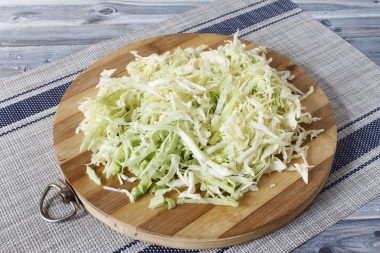
While the dough is resting, prepare the filling. Remove the top leaves from the cabbage, if they are spoiled, and finely chop it. It is better to use young cabbage - it is juicier than the old one, and the filling from it will turn out more tender.
Step 9:

Peel the carrots and grate them on a coarse grater. Peel the onion and chop it with a knife. This slicing is best suited for filling.
Step 10:
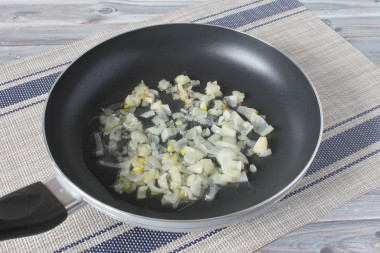
Heat the vegetable oil in a frying pan, put the onion and add a pinch of salt so that it gives juice. Fry it while stirring over medium heat on a medium burner for a couple of minutes. If you have a non-stick frying pan, then stir with a wooden spatula. The onion should become transparent and not burn.
Step 11:

Add the carrots to the onion, stir and fry for a couple more minutes until the vegetables are soft.
Step 12:
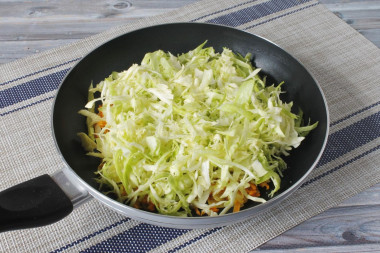
Add cabbage to the vegetables and add salt to taste - I added a couple of pinches of ordinary table salt.
Step 13:
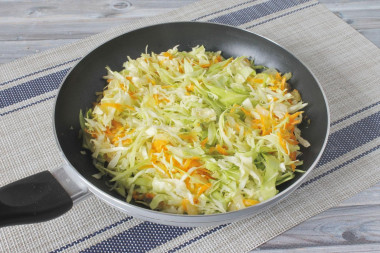
Stir, cover the pan with a lid and simmer the cabbage over moderate heat until cooked with infrequent stirring - I stirred twice. At that stage, you can also add tomato paste to the filling.
Step 14:

Cabbage should be soft and should not burn. How to determine the readiness of cabbage? Try it - if it doesn't crunch, then it's ready. It took me 10 minutes to cook. Transfer the filling to another container and let it cool. If you use old cabbage, then it should be stewed a little longer and you may have to add water, because it is not as juicy as young.
Step 15:
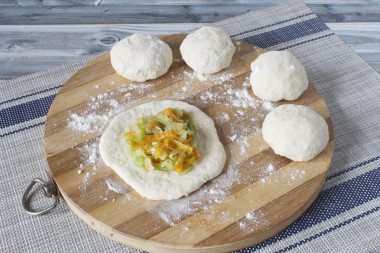
Forming pies. Divide the dough into several equal parts, pinching it with your hands. I got 10 pieces weighing about 55 grams. Roll each piece into a ball and roll it lightly in flour. Take one ball, mash it with your hands into a flat cake (I kneaded it to a thickness of about 2 mm) and put the filling in the middle - about a tablespoon with a slide.
Step 16:

Pinch the edges, forming an oval patty, and slightly flatten it.
Step 17:
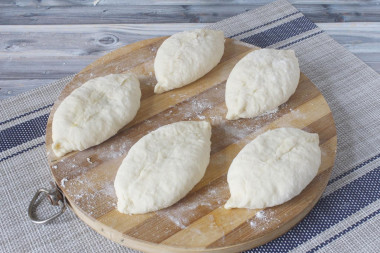
In this way, form the remaining pies. I got medium-sized pies.
Step 18:
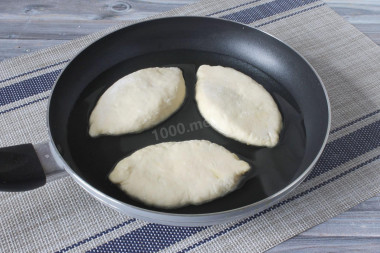
Put the pan on medium heat and pour oil, but not all at once. I have a frying pan with a diameter of 22 cm, I poured 100 ml of oil, then topped up as it was fried. The oil level should be such that the oil reaches half of the pies. When the oil is well calcined, lay out the first batch of pies seam down at a small distance from each other (they will increase). Make a moderate fire and fry the pies until browned. It took me 7 minutes.
Step 19:

Turn the pies over and fry until tender. It took me about 5 more minutes. In this way we fry all the pies. Add oil as it is fried and warm it up.
Step 20:

The pies were not greasy, so I did not put them on a napkin, but immediately on a dish.
They cook quickly, they turn out delicious! You can cook pies from this dough and with other fillings: potatoes, cottage cheese, jam, etc. And finally one more tip: to check that the oil is well warmed up, dip a wooden stick into it, bubbles should form around it.
--------------------
Article to help:
Wheat flour. Secrets and nuances of use
Caloric content of the products possible in the composition of the dish
- Onion - 41 kcal/100g
- Chicken egg - 157 kcal/100g
- Egg white - 45 kcal/100g
- Egg powder - 542 kcal/100g
- Egg yolk - 352 kcal/100g
- Ostrich egg - 118 kcal/100g
- Carrots - 33 kcal/100g
- Dried carrots - 275 kcal/100g
- Boiled carrots - 25 kcal/100g
- Whole durum wheat flour fortified - 333 kcal/100g
- Whole durum wheat flour, universal - 364 kcal/100g
- Flour krupchatka - 348 kcal/100g
- Flour - 325 kcal/100g
- Granulated sugar - 398 kcal/100g
- Sugar - 398 kcal/100g
- Kefir fat - 62 kcal/100g
- Kefir of 1% fat content - 38 kcal/100g
- Low-fat kefir - 30 kcal/100g
- Kefir "doctor beefy" 1,8% fat content - 45 kcal/100g
- Kefir 2.5% fat content - 53 kcal/100g
- Vegetable oil - 873 kcal/100g
- Salt - 0 kcal/100g
- White cabbage - 28 kcal/100g
- Boiled white cabbage - 21 kcal/100g
- Baking soda - 0 kcal/100g


